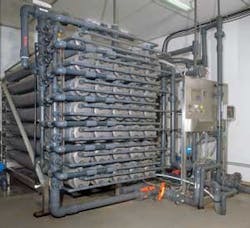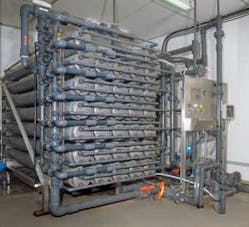By David Pearson
The EPA’s Long Term 2 Enhanced Surface Water Treatment Rule stipulates risk-targeted additional treatment requirements for surface water and groundwater under the influence of surface water to further protect public health against Cryptosporidium and other microbial pathogens in drinking water. The rule principally targets chlorine resistant cryptosporidium. Surface water treatment plants must remove at least 99% (log2) of cryptosporidium, and up to log 5.5 for the most at risk source waters.
Membrane processes are a highly efficient barrier to Cryptosporidium and Table IV.D–1 of the LT2ESWTR grants membranes a log credit equivalent to the removal efficiency demonstrated in a challenge test for the device, if supported by direct integrity testing. A challenge test will normally show at least log 5.5 removal. However “for the purposes of today’s (LT2) rule” (Section IV.D-11.a) a membrane system is only a membrane system if it has a direct integrity test. The industry standard for an integrity test uses compressed air, which is relatively simple to design into a hollow fiber membrane system but presents additional engineering challenges for spiral and tubular membranes.
The Fyne Process by ITT has been installed in Europe and North America for over 12 years. It was originally developed as a chemical free process for treating surface waters containing high levels of organics which, if not removed, would form disinfection by-products after chlorination. As a nanofiltration membrane process, it also acts as a barrier to bacteria and viruses. Its tubular membrane configuration, however, makes an integrity test more difficult to design, and if it could be done successfully, would add complexity and cost that goes against the original design concept of a low maintenance, low complexity package plant.
Without a direct integrity test it cannot be defined as a membrane system under LT2ESWTR and cannot therefore be granted the high log credit it would achieve under a challenge test. So what can it be defined as? As a pressure-driven separation device that removes particulate matter larger than 1 micrometer using an engineered porous filtration media in which the direction of flow is from the inside of the “bag” to outside, the tubular membrane configuration does meet the rule’s general definition of a bag filter.
Bag and cartridge filter systems can receive Cryptosporidium treatment credit of up to 2.0-log, as long as certain additional challenge test requirements are met. Could the Fyne system reasonably be granted up to log 2 credit under LT2 as a bag filter?
UV is a highly efficient inactivator of cryptosporidium and provided the water is already filtered, a 22 mJ/cm² dose from a low pressure mercury lamp is given log 4 credit. (Table IV.D–5).
ITT has therefore added to its standard Fyne Process the option to install a UV system downstream of the membrane filter. The combined package might then be awarded the full log 5.5 credit in a multi-barrier approach, which would then relieve small systems of the burden of source water monitoring.
The first systems with this multi-barrier approach have been delivered to Quebec. The State of Alaska is currently considering this approach with a small mobile system, for which source water monitoring would present additional challenges.
About the Author:
David Pearson is the Membrane Marketing Manager for ITT WWW Leopold. He has been in the membrane filtration field for over 20 years working both in the United States and the UK and has worked with the Fyne process from its development in Europe in the early 1990s.




